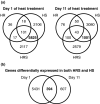Heating quinoa shoots results in yield loss by inhibiting fruit production and delaying maturity
- PMID: 31971639
- PMCID: PMC7318176
- DOI: 10.1111/tpj.14699
Heating quinoa shoots results in yield loss by inhibiting fruit production and delaying maturity
Abstract
Increasing global temperatures and a growing world population create the need to develop crop varieties that provide higher yields in warmer climates. There is growing interest in expanding quinoa cultivation, because of the ability of quinoa to produce nutritious grain in poor soils, with little water and at high salinity. The main limitation to expanding quinoa cultivation, however, is the susceptibility of quinoa to temperatures above approximately 32°C. This study investigates the phenotypes, genes and mechanisms that may affect quinoa seed yield at high temperatures. Using a differential heating system where only roots or only shoots were heated, quinoa yield losses were attributed to shoot heating. Plants with heated shoots lost 60-85% yield as compared with control plants. Yield losses were the result of lower fruit production, which lowered the number of seeds produced per plant. Furthermore, plants with heated shoots had delayed maturity and greater non-reproductive shoot biomass, whereas plants with both heated roots and heated shoots produced higher yields from the panicles that had escaped the heat, compared with the control. This suggests that quinoa uses a type of avoidance strategy to survive heat. Gene expression analysis identified transcription factors differentially expressed in plants with heated shoots and low yield that had been previously associated with flower development and flower opening. Interestingly, in plants with heated shoots, flowers stayed closed during the day while the control flowers were open. Although a closed flower may protect the floral structures, this could also cause yield losses by limiting pollen dispersal, which is necessary to produce fruit in the mostly female flowers of quinoa.
Keywords: RNA-seq; fruit production; heat; phenomics; plant maturity; quinoa; yield.
© 2020 The Authors. The Plant Journal published by Society for Experimental Biology and John Wiley & Sons Ltd.
Conflict of interest statement
The authors declare that they have no conflicts of interest.
Figures








Similar articles
-
Genotypic differences in agro-physiological, biochemical and isotopic responses to salinity stress in quinoa (Chenopodium quinoa Willd.) plants: Prospects for salinity tolerance and yield stability.Plant Physiol Biochem. 2018 Aug;129:411-420. doi: 10.1016/j.plaphy.2018.06.023. Epub 2018 Jun 19. Plant Physiol Biochem. 2018. PMID: 30691637
-
Investigation into the underlying regulatory mechanisms shaping inflorescence architecture in Chenopodium quinoa.BMC Genomics. 2019 Aug 17;20(1):658. doi: 10.1186/s12864-019-6027-0. BMC Genomics. 2019. PMID: 31419932 Free PMC article.
-
RNA-seq Analysis of Salt-Stressed Versus Non Salt-Stressed Transcriptomes of Chenopodium quinoa Landrace R49.Genes (Basel). 2019 Dec 16;10(12):1042. doi: 10.3390/genes10121042. Genes (Basel). 2019. PMID: 31888133 Free PMC article.
-
Identification and Characterization of Contrasting Genotypes/Cultivars for Developing Heat Tolerance in Agricultural Crops: Current Status and Prospects.Front Plant Sci. 2020 Oct 22;11:587264. doi: 10.3389/fpls.2020.587264. eCollection 2020. Front Plant Sci. 2020. PMID: 33193540 Free PMC article. Review.
-
Quinoa bitterness: causes and solutions for improving product acceptability.J Sci Food Agric. 2018 Aug;98(11):4033-4041. doi: 10.1002/jsfa.8980. Epub 2018 Apr 30. J Sci Food Agric. 2018. PMID: 29485194 Review.
Cited by
-
Changes in the content and accumulation of macroelements in different parts of the quinoa plant biomass Chenopodium quinoa willd.Sci Rep. 2025 Jul 2;15(1):22918. doi: 10.1038/s41598-025-04797-5. Sci Rep. 2025. PMID: 40594185 Free PMC article.
-
Changes in Quinoa Seed Fatty Acid Profile Under Heat Stress Field Conditions.Front Nutr. 2022 Mar 28;9:820010. doi: 10.3389/fnut.2022.820010. eCollection 2022. Front Nutr. 2022. PMID: 35419388 Free PMC article.
-
A chromosome-scale assembly of the quinoa genome provides insights into the structure and dynamics of its subgenomes.Commun Biol. 2023 Dec 13;6(1):1263. doi: 10.1038/s42003-023-05613-4. Commun Biol. 2023. PMID: 38092895 Free PMC article.
-
Heat stress changes mineral nutrient concentrations in Chenopodium quinoa seed.Plant Direct. 2022 Feb 6;6(2):e384. doi: 10.1002/pld3.384. eCollection 2022 Feb. Plant Direct. 2022. PMID: 35146239 Free PMC article.
-
Root restriction accelerates genomic target identification in quinoa under controlled conditions.Physiol Plant. 2025 Mar-Apr;177(2):e70223. doi: 10.1111/ppl.70223. Physiol Plant. 2025. PMID: 40231839 Free PMC article.
References
-
- Abdelbar, O.H. (2018) Flower vascularization and fruit developmental anatomy of quinoa (Chenpodium quinoa Willd) Amaranthaceae. Sci. Ann. Univ. Agric. Sci. Vet. Med. 63, 67–75.
-
- Alexander, M.P. (1969) Differential staining of aborted and nonaborted pollen. Stain Technol. 44, 117–122. - PubMed
-
- Andrews, S. , Krueger, F. , Segonds‐Pichon, A. , Biggins, L. , Krueger, C. and Wingett, S. (2012) FastQC.
-
- Awika, J.M. (2011) Major cereal grains production and use around the world In Advances in Cereal Science: Implications to Food Processing and Health Promotion. ACS Symposium Series. Washington, D.C.: American Chemical Society, pp. 1–13.
Publication types
MeSH terms
LinkOut - more resources
Full Text Sources
Molecular Biology Databases

